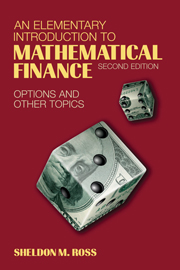Book contents
- Frontmatter
- Contents
- Introduction and Preface
- 1 Probability
- 2 Normal Random Variables
- 3 Geometric Brownian Motion
- 4 Interest Rates and Present Value Analysis
- 5 Pricing Contracts via Arbitrage
- 6 The Arbitrage Theorem
- 7 The Black–Scholes Formula
- 8 Additional Results on Options
- 9 Valuing by Expected Utility
- 10 Optimization Models
- 11 Exotic Options
- 12 Beyond Geometric Brownian Motion Models
- 13 Autogressive Models and Mean Reversion
- Index
10 - Optimization Models
Published online by Cambridge University Press: 05 June 2012
- Frontmatter
- Contents
- Introduction and Preface
- 1 Probability
- 2 Normal Random Variables
- 3 Geometric Brownian Motion
- 4 Interest Rates and Present Value Analysis
- 5 Pricing Contracts via Arbitrage
- 6 The Arbitrage Theorem
- 7 The Black–Scholes Formula
- 8 Additional Results on Options
- 9 Valuing by Expected Utility
- 10 Optimization Models
- 11 Exotic Options
- 12 Beyond Geometric Brownian Motion Models
- 13 Autogressive Models and Mean Reversion
- Index
Summary
Introduction
In this chapter we consider some optimization problems involving one-time investments not necessarily tied to the movement of a publicly traded security. Section 10.2 introduces a deterministic optimization problem where the objective is to determine an efficient algorithm for finding the optimal investment strategy when a fixed amount of money is to be invested in integral amounts among n projects, each having its own return function. Section 10.2.1 presents a dynamic programming algorithm that can always be used to solve the preceding problem; Section 10.2.2 gives a more efficient algorithm that can be employed when all the project return functions are concave; and Section 10.2.3 analyzes the special case, known as the knapsack problem, where project investments are made by purchasing integral numbers of shares, with each project return being a linear function of the number of shares purchased. Models in which probability is a key factor are considered in Section 10.3. Section 10.3.1 is concerned with a gambling model having an unknown win probability, and Section 10.3.2 examines a sequential investment allocation model where the number of investment opportunities is a random quantity.
A Deterministic Optimization Model
Suppose that you have m dollars to invest among n projects and that investing x in project i yields a (present value) return of fi(x), i = 1, = n. The problem is to determine the integer amounts to invest in each project so as to maximize the sum of the returns.
Information
- Type
- Chapter
- Information
- An Elementary Introduction to Mathematical FinanceOptions and other Topics, pp. 181 - 195Publisher: Cambridge University PressPrint publication year: 2002
